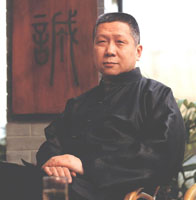|
|

|
|
TRANQUILITY: Ma Weidu, the owner of China's first private museum, finds time to relax surrounded by his many antiques |
"I seldom consider the difficulties before I do something," said Ma. However, this time the difficulties did indeed turn out to be many. It took him more than four years to get approval from the government for establishing the museum. In 1997, he finally set up his operation, but had to move several times before eventually settling down in Zhangwanfen in 2004.
"Our museum grows very fast. Now it occupies about 4,000 square meters. In downtown Beijing the rent would be much higher for a place as big as this, and that is one of the reasons we have settled in Zhangwanfen," said Ma.
When it comes to putting a value on the museum's collection, Ma said it is not easy since the prices are not fixed as is the case with most goods on other markets. He gave an example of a bottle made in the Song Dynasty (960-1279). A Japanese collector sold a similar bottle, which was not in as good condition as Ma's for more than 10 million yuan ($1.46 million) on the international market.
Another antique that impresses visitors is a pair of Buddhist towers made of red sandalwood. The 2.16-meter-high towers are birthday gifts from an emperor in the Qing Dynasty to his mother. This pair of towers were taken to England more than 100 years ago. In 2003, the towers appeared at Sotheby's Hong Kong auction, where Ma paid 3.628 million yuan ($530,800) for them. "A lot of bidders didn't know at first that it was made of red sandalwood, so I finally could get it at a very low price, " he said. The towers are today the most valuable pieces in the museum.
Guanfu Museum also opened branches in two other cities. One in Hangzhou, the capital city of east China's Zhejiang Province, was opened in 2001, and another one in Xiamen, a city in south China's Fujian Province, in 2005.
Right place, right time
Normally, to be a collector, one either has precious family heirlooms handed down from the older generations or has a lot of money. Ma has neither, which is why some people call him a "grassroots" collector.
"I am just lucky to be born at the right time for antique collection," Ma said, when asked about his achievements.
When he started his collection in the 1980s, there were few people interested in antiques and they were sold at very low prices. "At that time, my salary was just 30 ($4.38) or 40 yuan ($5.84) per month, and an old plate from the Qing Dynasty was worth only 5 yuan ($0.73). Even when I was cheated, it was not a big deal." A similar plate would fetch at least 500,000 yuan ($73,000) today. "Now, people cannot be so lucky to find bargains as there is wider knowledge of antiques and their value," said Ma.
In the 1990s, after almost 10 years of experience in antique collecting, Ma had become an expert in the field. His friends who couldn't understand him in the very beginning came to realize what this "crazy" man had already achieved. After dropping out of literature circles for more than 10 years, Ma showed up again as a figure in a different field.
|
